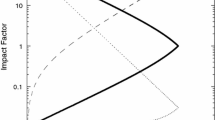Abstract
The relation between the frequency and rank forms and the connection of the parameters of the corresponding model scientometric distributions is discussed. Besides, while using the probabilistic interpretation of the data which are presented as a sample from a model population, the behaviour of the extreme values is examined. For example, the median μ of the distribution of the maximal values for the samples of the size N from the Zipf-Pareto distribution, which is typical for social phenomena, increases faster than the sample size N if α<1: μ∼ const.N 1/α. The knowledge of the asymptotical behaviour of the characteristics of the extreme values is necessary for the adequate modelling in scientometrics.
Similar content being viewed by others
Notes and references
S. D. HAITUN. Stationary scientometric distributions. Part I. The different approximations,Scientometrics, 4 (1982) 5; Part II. Non-Gaussian nature of scientific activities,Ibid., Scientometrics, 4 (1982) 89; Part III. The role of the Zipf distribution,Ibid. Scientometrics, 4 (1982) 181.
For example, thermodynamic interpretation of the parameters of collections of scientific publications, the use of a branching process for the modelling of scientific activity, etc. see A. I. YABLONSKY, Stokhasticheskie modeli nauchnoi deyatel'nosti (Stochastic models of scientific activities), in:Sistemnye issledovaniya, Yezhegodnik — 1975 (System Research, Yearbook 1975), Nauka, Moskva, 1976, pp. 5–42; V. M. PETROV, A. I. YABLONSKY,Matematika i sotsialnye protsessy: Giperbolicheskie raspredeleniya i ikh primenenie (Mathematics and Social Processes: Hyperbolic Distributions and their Application), Znanie, Moskva, 1980, p. 64.
The problem concerning relations between the rank and frequency forms of empirical distributions was touched repeatedly from different points of view while analysing scientometric data. See: A. I. YABLONSKY, On fundamental regularities of the distribution of scientific productivity,Scientometrics, 2 (1980) 3; S. D. HAITUN, The “rank distortion” effect and non-Gaussian nature of scientific activities,Scientometrics, 5 (1983) 375; B. HILL, Rank frequency forms of Zipf's law,Journal of the American Statistical Association, 69 (1974) 1017; B. C. BROOKES, J. M. GRIFFITHS, Frequency-rank distribution,Journal of the American Society for Information Science, 29 (1978) 5; B. C. BROOKES, Towards informetrics: Haitun, Laplace, Zipf, Bradford and the Alvey programme,Journal of Documentation, 40 (1984) 120; J. J. HUBERT, A rank-frequency model for scientific productivity,Scientometrics, 3 (1981) 191; M. V. ARAPOV, E. N. EFIMOVA, Y. A. SHREIDER, O smysle rangovykh raspredelenij (About the sense of rank distributions),Nauchno-Tekhnicheskaya Informatsiya Ser. 2, 1975 (1) (1975) 9; see also notes 1, 2.
S. D. HAITUN,Naukometriya: sostoyanie i perspektivy (Scientometrics: State and Prospects), Nauka, Moskva, 1983, p. 165.
See: A. I. YABLONSKY,, 3; A. I. YABLONSKY, Stable non-Gaussian distributions in scientometrics,Scientometrics, 7 (1985) 459; S. D. HAITUN, op. cit., notes 1, 3, 4,; S. D. Haitun. Stationary scientometric distributions. Part I. The different approximations,Scientometrics, 4 (1982) 5. A. I. YABLONSKY, On fundamental regularities of the distribution of scientific productivity,Scientometrics, 2 (1980) 3; S. D. HAITUN,Naukometriya: sostoyanie i perspektivy (Scientometrics: State and Prospects), Nauka, Moskva, 1983, p. 165. B. C. BROOKES, op. cit., note 3. S. D. Haitun. Stationary scientometric distributions. Part I. The different approximations, scientific productivity,Scientometrics, 2 (1980) 3;
See:
Such artefacts occur while passing from discrete distributions to continuous. See, for example: S. D. HAITUN,.
See, for example: S. D. HAITUN,, 4.
See, for example: V. N. GUBANKOV, N. L. DRONINA, O vremennoj evolyutsii rasseyaniya nauchnykh dokumentov v periodicheskikh izdaniyakh (About the time evolution of the dispersion of the scientific documents in the periodicals),Nauchno-Tekhnicheskaya Informatsiya Ser. 1, 1984 (6) (1984); see also: S. D. HAITUN, op. cit., notes 1, 4.
See: J. C. WILLIS,Age and Area, Cambridge Univ. Press, Cambridge, 1922.
See: S. D. HAITUN,.
Author information
Authors and Affiliations
Rights and permissions
About this article
Cite this article
Mokhov, O.I. About statistics of the extreme values and the rank form of scientometric distributions. Scientometrics 15, 87–96 (1989). https://doi.org/10.1007/BF02021801
Received:
Issue Date:
DOI: https://doi.org/10.1007/BF02021801




